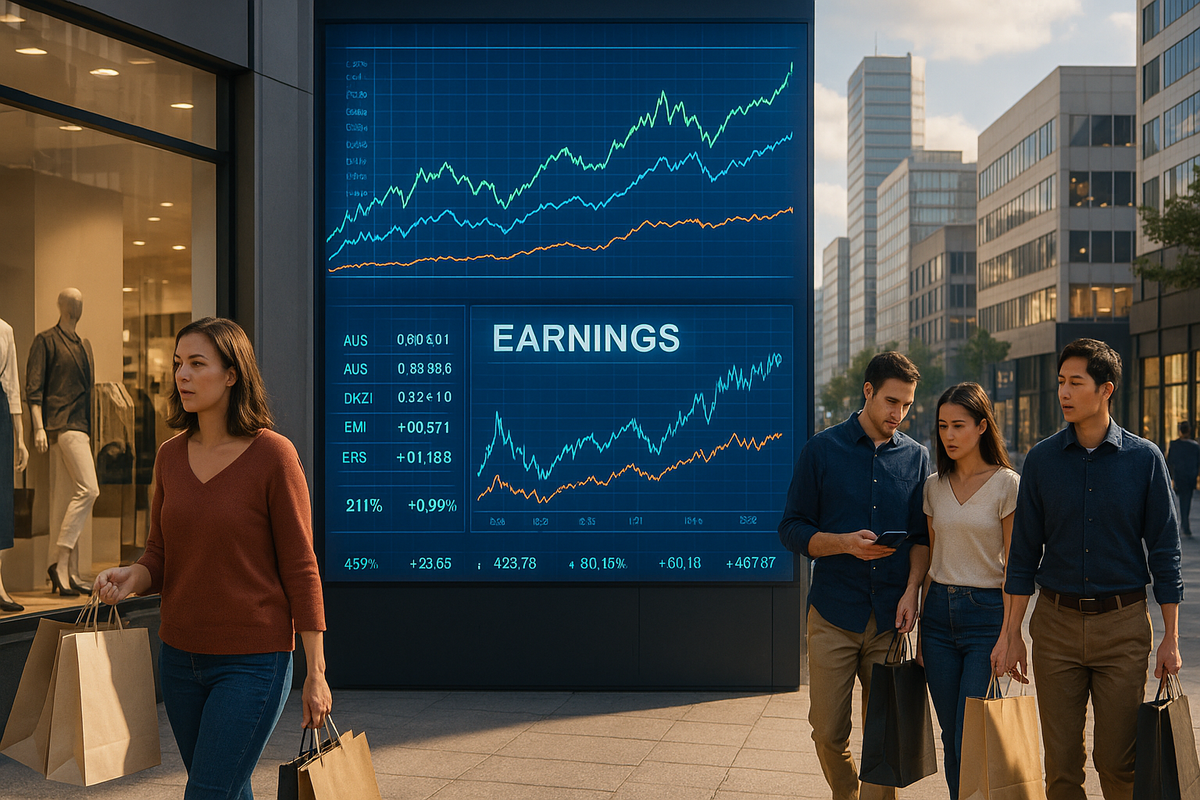
The second-quarter earnings season for the retail sector has delivered a mixed, yet telling, narrative about the state of the American consumer and the broader economic landscape. As inflation persists and economic uncertainties loom, investors have been scrutinizing these reports for vital clues on consumer spending habits, the effectiveness of retailers' strategies, and the overall health of the economy. The performance of major players, from home improvement giants to discount retailers, paints a complex picture of resilience in some segments and significant headwinds in others, setting the stage for a cautious outlook as the industry navigates evolving consumer priorities.
This period is particularly crucial as it offers a direct pulse on consumer confidence and purchasing power, revealing how households are prioritizing their spending amidst ongoing inflationary pressures. The varied results across the sector highlight a clear divergence: while essential goods and value-oriented offerings continue to see demand, discretionary spending remains under pressure, forcing retailers to adapt their strategies and manage expectations for the remainder of the year.
A Shifting Landscape: Q2 Retail Performance Unveiled
The Q2 retail earnings season has been a pivotal moment, offering a granular view into the challenges and adaptations within the sector. While the overall S&P 500 earnings per share (EPS) growth for Q2 showed an increase, the retail sector's performance, particularly when excluding e-commerce behemoths, revealed a more subdued picture. Many retailers grappled with persistent inflationary pressures, shifts in consumer spending patterns, and the ongoing impact of a tightening job market.
Home Depot (NYSE: HD) affirmed its full-year guidance, signaling stability in the home improvement sector despite a slight miss on revenue expectations. The company's comparable sales saw a positive rebound, particularly in the U.S., indicating a resilient demand for smaller home improvement projects and continued strength in its "Pro" segment. This affirmation provides a sense of confidence to investors, suggesting that management believes their strategic initiatives will allow them to meet annual targets.
Lowe's (NYSE: LOW) also delivered a better-than-expected profit, with revenue meeting forecasts. The company's return to positive comparable sales, driven by both professional and DIY segments, marked a significant turnaround from the previous quarter. Lowe's strategic acquisition of Artisan Design Group (ADG) is expected to further bolster its position in the new home construction market, contributing to an optimistic outlook for the remainder of the fiscal year.
In contrast, Target (NYSE: TGT) faced a more challenging quarter, reporting a decline in profit despite exceeding revenue expectations. The company's sales have been slumping for several quarters, and the announcement of a new CEO, Michael Fiddelke, amidst these struggles underscores the urgency for a strategic pivot. Target's reliance on discretionary items, coupled with consumer pullback and intense competition, has made it particularly vulnerable in the current economic climate.
Walmart (NYSE: WMT) continued its strong performance, exceeding its own internal guidance with robust sales growth and significant digital engagement. The retail giant's focus on essential goods, coupled with strategic pricing and AI-driven inventory optimization, allowed it to outperform many peers. Walmart's ability to expand gross margins despite inflationary pressures highlights its operational efficiency and resilience.
TJX Companies (NYSE: TJX), the parent company of TJ Maxx, also reported a robust quarter, with both revenue and profit surpassing analyst expectations. The off-price retailer's model, which emphasizes value and opportunistic buying, continues to resonate with budget-conscious shoppers, driving strong consumer demand across its various divisions. This performance underscores the growing trend of consumers trading down to lower-priced products in the current economic environment.
Winners and Losers in the Retail Arena
The Q2 earnings season has clearly delineated the winners and losers in the retail sector, largely based on their product mix, pricing strategies, and ability to adapt to evolving consumer behaviors. Companies focused on essential goods and value offerings have generally thrived, while those heavily reliant on discretionary spending have faced significant headwinds.
Home Depot and Lowe's, while operating in a segment that can be considered discretionary, have demonstrated resilience due to the ongoing demand for home improvement projects, both large and small. Home Depot's affirmation of guidance and Lowe's return to positive comparable sales indicate that consumers are still investing in their homes, albeit with a potential shift towards smaller, more manageable projects. The strength in their "Pro" segments also highlights a robust commercial demand that provides a stable revenue stream. These companies have effectively navigated supply chain challenges and managed costs, allowing them to maintain profitability and provide a relatively optimistic outlook.
Walmart and TJX Companies have emerged as clear winners, capitalizing on the consumer's increasing focus on value and essentials. Walmart's dominance in groceries and household staples, combined with its aggressive pricing strategies and expanding e-commerce presence, has allowed it to capture a larger share of consumer spending. The company's ability to manage inventory efficiently and leverage technology for optimization has further bolstered its margins. TJX Companies, with its off-price model, has directly benefited from consumers trading down and seeking bargains. Their diverse brand portfolio and agile sourcing have enabled them to offer compelling value, attracting a broad customer base even as discretionary spending tightens elsewhere. These companies are well-positioned to continue their growth trajectory as economic uncertainties persist, as their business models inherently cater to cost-conscious consumers.
On the other hand, Target has found itself in a more precarious position. Its heavier reliance on discretionary categories like apparel, home decor, and electronics has made it particularly vulnerable to shifts in consumer spending. As consumers prioritize essential purchases, demand for these non-essential items has softened, leading to slumping sales and declining profits. The company's challenges are compounded by intense competition from both traditional retailers and e-commerce giants, as well as internal issues such as inventory management and the impact of past controversies. The leadership transition at Target underscores the urgent need for a strategic overhaul to regain market share and re-establish its value proposition in a highly competitive and evolving retail landscape.
Industry Impact and Broader Implications
The Q2 retail earnings reports offer significant insights into broader industry trends and the overall economic outlook. The divergence in performance among retailers underscores a fundamental shift in consumer behavior: a clear prioritization of essential goods and value-driven purchases over discretionary items. This trend is a direct consequence of persistent inflation and economic uncertainty, forcing households to be more judicious with their spending.
This shift has profound implications for the entire retail ecosystem. Retailers heavily invested in discretionary categories are facing increased pressure to innovate, offer compelling value, and differentiate themselves to attract cautious consumers. This could lead to more aggressive promotional activities, a greater focus on private labels, and a re-evaluation of product assortments. Conversely, companies like Walmart and TJX Companies, which are inherently aligned with value and essential needs, are likely to continue gaining market share. This dynamic could accelerate consolidation within the retail sector, as smaller or less adaptable players struggle to compete.
Beyond individual company performance, these earnings reports provide a crucial barometer for the broader economy. The resilience of essential spending suggests that while consumers are tightening their belts, they are not entirely pulling back. However, the weakness in discretionary categories signals a potential slowdown in overall economic growth, as consumer spending accounts for a significant portion of GDP. This could have ripple effects on manufacturing, logistics, and employment across various sectors. Regulatory bodies and policymakers will be closely watching these trends, as sustained weakness in consumer spending could prompt further interventions or adjustments to monetary policy. Historically, periods of high inflation and economic uncertainty have often led to similar shifts in consumer behavior, with value-oriented retailers typically outperforming. The current environment appears to be following this pattern, reinforcing the importance of agility and adaptability for retailers to thrive.
What Comes Next
The Q2 retail earnings season has set the stage for a challenging yet potentially transformative period for the industry. In the short term, retailers will likely continue to grapple with cautious consumer spending, persistent inflationary pressures, and intense competition. We can expect to see a heightened focus on inventory management, with retailers employing more sophisticated data analytics and AI-driven tools to optimize stock levels and minimize markdowns. Promotional activity is also likely to intensify as companies vie for a shrinking pool of discretionary dollars, particularly heading into the crucial back-to-school and holiday shopping seasons.
In the long term, the retail landscape is poised for significant strategic pivots. Companies that have struggled in Q2, like Target, will need to re-evaluate their product mix, supply chains, and customer engagement strategies. This could involve a greater emphasis on private brands, a streamlining of operations, and increased investment in digital capabilities to enhance the online shopping experience. For the winners, such as Walmart and TJX Companies, the focus will be on sustaining momentum by further solidifying their value propositions, expanding their market reach, and continuing to innovate in areas like last-mile delivery and personalized marketing.
Market opportunities may emerge for retailers that can effectively cater to the evolving consumer demand for both value and convenience. This could include the growth of omnichannel models that seamlessly integrate online and in-store experiences, as well as the expansion of "buy now, pay later" options to ease the financial burden on consumers. Challenges will persist in managing rising labor costs, navigating geopolitical uncertainties that impact supply chains, and adapting to potential shifts in regulatory environments. Potential scenarios range from a continued bifurcation of the market, with value and essential retailers thriving while discretionary players struggle, to a more widespread recovery if inflationary pressures ease and consumer confidence rebounds. The coming months will be critical in determining which retailers can successfully adapt and emerge stronger from this period of economic flux.
Conclusion
The Q2 retail earnings season has provided a comprehensive, albeit complex, snapshot of the current economic climate and its profound impact on consumer behavior. The key takeaway is a clear divergence in performance, with retailers focused on essential goods and value offerings demonstrating resilience and even growth, while those heavily reliant on discretionary spending face significant headwinds. This underscores the ongoing pressure on household budgets due to persistent inflation and economic uncertainty, leading consumers to prioritize needs over wants.
Moving forward, investors should closely monitor several key indicators. The trajectory of inflation and interest rates will be paramount, as these macroeconomic factors directly influence consumer purchasing power. Retailers' ability to manage inventory effectively, control costs, and adapt their pricing strategies will also be crucial for maintaining profitability. Furthermore, the evolution of consumer spending patterns, particularly the balance between essential and discretionary purchases, will dictate the success of various retail segments. The strategic pivots and innovations undertaken by companies like Target, as they navigate leadership changes and sales challenges, will be particularly insightful.
Ultimately, the Q2 earnings reports highlight the enduring significance of adaptability and a clear value proposition in the retail sector. While the immediate future may present continued challenges, the companies that can effectively respond to evolving consumer needs, optimize their operations, and embrace technological advancements are best positioned to not only weather the current economic storm but also emerge stronger in the long term. The retail reckoning is far from over, and the coming quarters will undoubtedly reveal further shifts and strategic responses within this dynamic industry.





